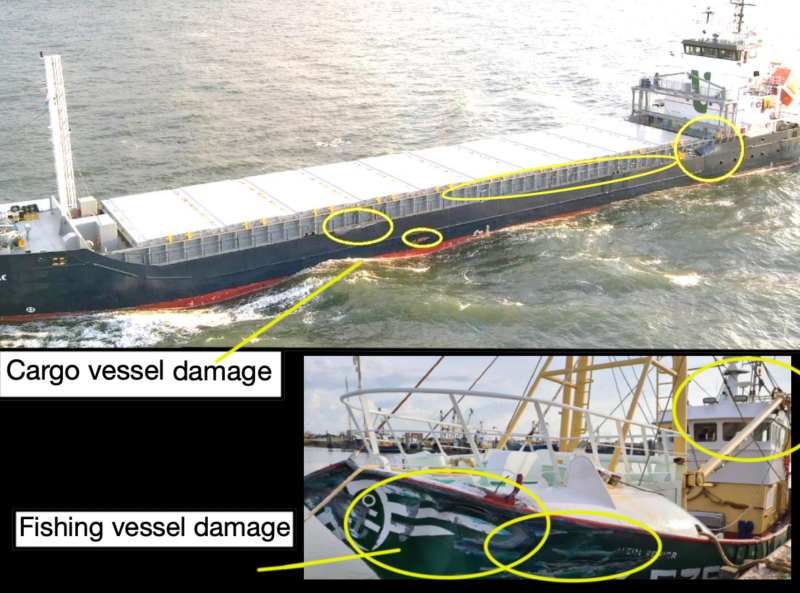202205 Collision with a fishing vessel in a TSS
As edited from official FEBIMA (Belgium) report 2020/005040
A general cargo vessel was sailing in a Traffic Separation Scheme (TSS) at night in calm seas and good visibility. The vessel was under autopilot, on a course of 249 degrees at approximately 10.5 knots. The Officer of the Watch (OOW) noticed four fishing vessels on the radar that were crossing the TSS and appeared to be sailing as a group. The fishing vessels were approximately 10.5 nm away and approaching on the port side, showing Closest Point of Approach (CPAs) of between 0.1 and 0.6 nm. The Time to Closest Point of Approach (TCPA) was approximately 50 minutes.
Some time later, the OOW set the radar to a 6 nm range. The radar indicated three CPA/TCPA limit alarms from the group of four fishing vessels. One of the fishing vessels altered course approximately 30° to port in order to cross ahead of the cargo vessel with a CPA of 0.4 nm.
Two of the other fishing boats, A and B, kept a course of approximately 006 degrees. At one point, fishing boat B altered course slowly towards 011 degrees to pass astern of the cargo vessel, but fishing vessel A did not follow this move. Its CPA to the cargo vessel was approximately .05 nm. In the following minutes, the OOW of the cargo vessel noticed that the CPA of fishing boat A had decreased to zero.
By this time another officer had arrived on the bridge of the cargo vessel for the change of watch. Before the handover could be accomplished the OOW on duty realised that fishing vessel A was not taking avoiding action. The OOW sounded the horn to warn fishing vessel A and then put the rudder hard to starboard. About 40 seconds after sounding the horn, the two vessels collided. Fishing vessel A ran into the port side of the cargo vessel amidships and then slid aft. Both vessels sustained structural damage but there were no injuries.
It was discovered during the investigation that the lone watchkeeper on board fishing vessel A did not realise the cargo vessel was there until it was too late. The investigation also found that the ‘apparent intentions’ of the four fishing vessels contributed to the accident. Some of the fishing vessels did take action to avoid the cargo vessel but in the end, one did not. The OOW on the cargo vessel assumed all the fishing vessel crews had observed his ship, but he was wrong.
Lessons Learned
- When in doubt and always when a very small CPA is detected, establish early communications with the other vessel and ensure everyone knows what actions are to be taken.
- Sound navigation practices and a good lookout would have avoided this accident as the Master of the fishing boat would have realised there was a stand-on cargo boat on his course with a zero CPA.

You may also like:
The drive for fishing vessel safety management. A Seafarer's Charity initiative
